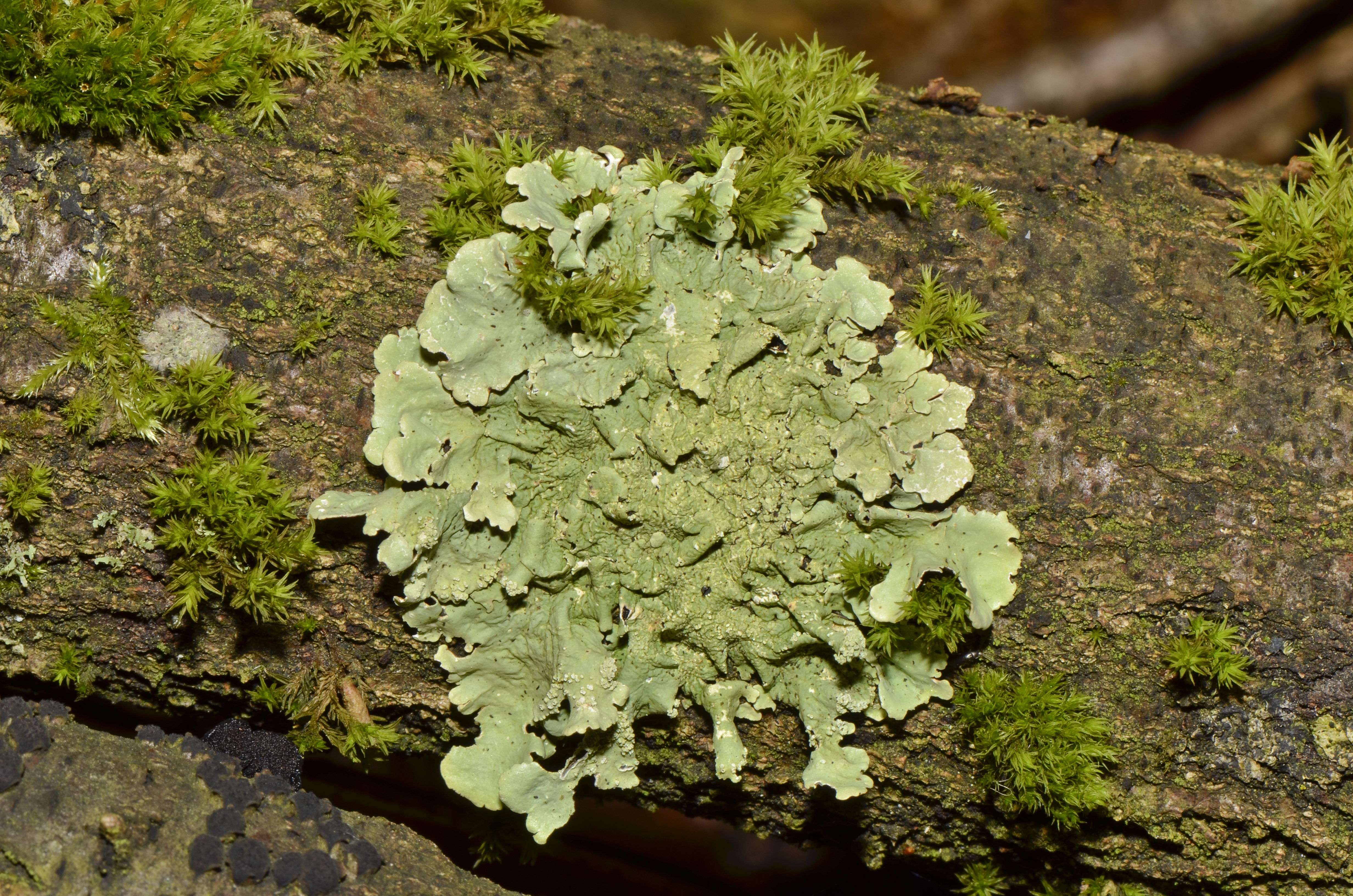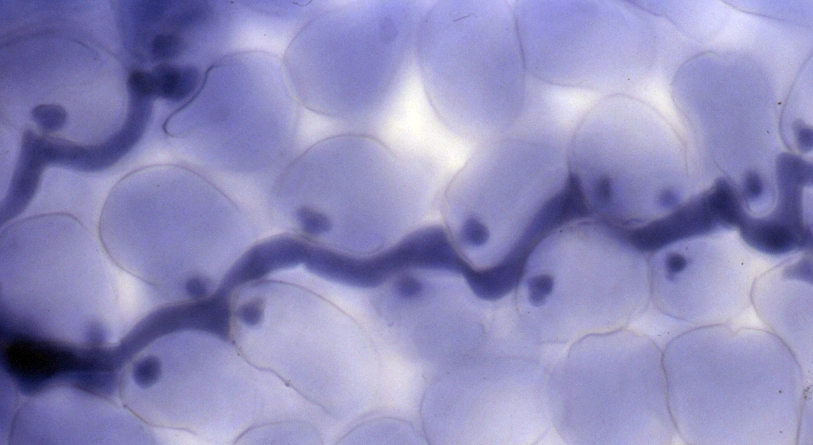|
Lichen Morphology
Lichen morphology describes the external appearance and structures of a lichen. These can vary considerably from species to species. Lichen growth forms are used to group lichens by "vegetative" thallus types, and forms of "non-vegetative" reproductive parts. Some lichen thalli have the aspect of leaves (foliose lichens); others cover the substrate like a crust (crustose lichens) (''illustration, right''), others such as the genus ''Ramalina'' adopt shrubby forms (fruticose lichens), and there are gelatinous lichens such as the genus ''Collema''. Although the form of a lichen is determined by the genetic material of the fungal partner, association with a photobiont is required for the development of that form. When grown in the laboratory in the absence of its photobiont, a lichen fungus develops as an undifferentiated mass of hyphae. If combined with its photobiont under appropriate conditions, its characteristic form emerges, in the process called morphogenesis.Brodo, Sharn ... [...More Info...] [...Related Items...] OR: [Wikipedia] [Google] [Baidu] |
Flavoparmelia Caperata - Lichen - Caperatflechte
''Flavoparmelia'' is a genus of foliose lichens in the family Parmeliaceae. Because of their appearance, they are commonly known as greenshield lichens. The widely distributed genus contains 32 species. It was circumscribed by American lichenologist Mason Hale in 1986 to contain 17 former '' Pseudoparmelia'' species with broad lobes, usnic acid in the cortex, and isolichenan in the cell walls. Description ''Flavoparmelia'' lichens are medium sized foliose lichens that are yellow-green in colour, with a thallus comprising rounded lobed that measure 2–8 mm wide, which form flat and loosely attached patches that are wide. Older parts of the upper thallus surface are wrinkled, while the newer parts are smooth. There is a black lower surface with simple, unbranched rhizines, and a distinct bare zone around the margin. The photobiont partner is green algae from genus ''Trebouxia''. ''Flavoparmelia'' has larger spores than other segregate genera of ''Pseudoparmelia''. Species ... [...More Info...] [...Related Items...] OR: [Wikipedia] [Google] [Baidu] |
Haustorium
In botany and mycology, a haustorium (plural haustoria) is a rootlike structure that grows into or around another structure to absorb water or nutrients. For example, in mistletoe or members of the broomrape family, the structure penetrates the host's tissue and draws nutrients from it. In mycology, it refers to the appendage or portion of a parasitic fungus (the hyphal tip), which performs a similar function. Microscopic haustoria penetrate the host plant's cell wall and siphon nutrients from the space between the cell wall and plasma membrane but do not penetrate the membrane itself. Larger (usually botanical, not fungal) haustoria do this at the tissue level. The etymology of the name corresponds to the Latin word ''haustor'' meaning ''the one who draws, drains or drinks'', and refers to the action performed by the outgrowth. In fungi Fungi in all major divisions form haustoria. Haustoria take several forms. Generally, on penetration, the fungus increases the surface ar ... [...More Info...] [...Related Items...] OR: [Wikipedia] [Google] [Baidu] |
Apothecia
An ascocarp, or ascoma (), is the fruiting body ( sporocarp) of an ascomycete phylum fungus. It consists of very tightly interwoven hyphae and millions of embedded asci, each of which typically contains four to eight ascospores. Ascocarps are most commonly bowl-shaped (apothecia) but may take on a spherical or flask-like form that has a pore opening to release spores (perithecia) or no opening (cleistothecia). Classification The ascocarp is classified according to its placement (in ways not fundamental to the basic taxonomy). It is called ''epigeous'' if it grows above ground, as with the morels, while underground ascocarps, such as truffles, are termed ''hypogeous''. The structure enclosing the hymenium is divided into the types described below (apothecium, cleistothecium, etc.) and this character ''is'' important for the taxonomic classification of the fungus. Apothecia can be relatively large and fleshy, whereas the others are microscopic—about the size of flecks of ... [...More Info...] [...Related Items...] OR: [Wikipedia] [Google] [Baidu] |
Pycnidia
A pycnidium (plural pycnidia) is an asexual fruiting body produced by mitosporic fungi, for instance in the order Sphaeropsidales ( Deuteromycota, Coelomycetes) or order Pleosporales (Ascomycota, Dothideomycetes). It is often spherical or inversely pearshaped ( obpyriform) and its internal cavity is lined with conidiophores. When ripe, an opening generally appears at the top, through which the pycnidiospore {{Short pages monitor [Baidu] |
Apothecium
An ascocarp, or ascoma (), is the fruiting body ( sporocarp) of an ascomycete phylum fungus. It consists of very tightly interwoven hyphae and millions of embedded asci, each of which typically contains four to eight ascospores. Ascocarps are most commonly bowl-shaped (apothecia) but may take on a spherical or flask-like form that has a pore opening to release spores (perithecia) or no opening (cleistothecia). Classification The ascocarp is classified according to its placement (in ways not fundamental to the basic taxonomy). It is called ''epigeous'' if it grows above ground, as with the morels, while underground ascocarps, such as truffles, are termed ''hypogeous''. The structure enclosing the hymenium is divided into the types described below (apothecium, cleistothecium, etc.) and this character ''is'' important for the taxonomic classification of the fungus. Apothecia can be relatively large and fleshy, whereas the others are microscopic—about the size of flecks ... [...More Info...] [...Related Items...] OR: [Wikipedia] [Google] [Baidu] |
Podetia
A podetium (plural: podetia) is the upright secondary thallus in ''Cladonia'' lichens. It is a hollow stalk extending from the primary thallus. Podetia can be pointed stalks, club like, cupped, or branched in shape and may or may not contain the ascocarp, the fruiting body, of the lichen. It is not considered part of the primary thallus as it is a fruiting structure for reproduction Reproduction (or procreation or breeding) is the biological process by which new individual organisms – "offspring" – are produced from their "parent" or parents. Reproduction is a fundamental feature of all known life; each individual or .... A lichen can be described as "podetiate" when it forms a podetium. References {{reflist Fungal morphology and anatomy ... [...More Info...] [...Related Items...] OR: [Wikipedia] [Google] [Baidu] |
Podetium
A podetium (plural: podetia) is the upright secondary thallus in ''Cladonia'' lichens. It is a hollow stalk extending from the primary thallus. Podetia can be pointed stalks, club like, cupped, or branched in shape and may or may not contain the ascocarp, the fruiting body, of the lichen. It is not considered part of the primary thallus as it is a fruiting structure for reproduction Reproduction (or procreation or breeding) is the biological process by which new individual organisms – "offspring" – are produced from their "parent" or parents. Reproduction is a fundamental feature of all known life; each individual or .... A lichen can be described as "podetiate" when it forms a podetium. References {{reflist Fungal morphology and anatomy ... [...More Info...] [...Related Items...] OR: [Wikipedia] [Google] [Baidu] |
Polysaccharide
Polysaccharides (), or polycarbohydrates, are the most abundant carbohydrates found in food. They are long chain polymeric carbohydrates composed of monosaccharide units bound together by glycosidic linkages. This carbohydrate can react with water (hydrolysis) using amylase enzymes as catalyst, which produces constituent sugars (monosaccharides, or oligosaccharides). They range in structure from linear to highly branched. Examples include storage polysaccharides such as starch, glycogen and galactogen and structural polysaccharides such as cellulose and chitin. Polysaccharides are often quite heterogeneous, containing slight modifications of the repeating unit. Depending on the structure, these macromolecules can have distinct properties from their monosaccharide building blocks. They may be amorphous or even insoluble in water. When all the monosaccharides in a polysaccharide are the same type, the polysaccharide is called a homopolysaccharide or homoglycan, but when more t ... [...More Info...] [...Related Items...] OR: [Wikipedia] [Google] [Baidu] |
Metabolite
In biochemistry, a metabolite is an intermediate or end product of metabolism. The term is usually used for small molecules. Metabolites have various functions, including fuel, structure, signaling, stimulatory and inhibitory effects on enzymes, catalytic activity of their own (usually as a cofactor to an enzyme), defense, and interactions with other organisms (e.g. pigments, odorants, and pheromones). A primary metabolite is directly involved in normal "growth", development, and reproduction. Ethylene exemplifies a primary metabolite produced large-scale by industrial microbiology. A secondary metabolite is not directly involved in those processes, but usually has an important ecological function. Examples include antibiotics and pigments such as resins and terpenes etc. Some antibiotics use primary metabolites as precursors, such as actinomycin, which is created from the primary metabolite tryptophan. Some sugars are metabolites, such as fructose or glucose, which are both p ... [...More Info...] [...Related Items...] OR: [Wikipedia] [Google] [Baidu] |
Rhizines
In lichens, rhizines are multicellular root-like structures, arising mostly from the lower surface. A lichen with rhizines is termed rhizinate, while a lichen lacking rhizines is termed erhizinate. Rhizines serve only to anchor the lichen to their substrate; they do not absorb nutrients as do plant roots. Characteristics of the rhizines are used to identify lichens, for example: whether they are dense or sparse, whether they are uniformly distributed or clumped in specific areas, and whether they are straight or branched. Only foliose lichens may possess rhizines, not crustose or fruticose lichens, which lack a lower cortex. Rhizohyphae are a type of attachment structure on some lichens. Rhizohyphae are more slender than rhizines and are one cell thick in diameter. Rhizohyphae often occur as a felt-like hyphal mass. See also *Rhizoid Rhizoids are protuberances that extend from the lower epidermal cells of bryophytes and algae. They are similar in structure and function to the r ... [...More Info...] [...Related Items...] OR: [Wikipedia] [Google] [Baidu] |
Foliose
Foliose lichen is one of the morphological classes of lichens, which are complex organisms that arise from the symbiotic relationship between fungi and a photosynthetic partner, typically algae. This partnership allows lichen to live in diverse climates that can range from cold, dry mountains to wet, warm valleys. Lichens develop quite slowly with recorded growth rates of 0.01–27mm/year depending on the species. Their lifespan averages between 30 and 60 years. Lichens have a main body part called the thallus, which is composed of hyphae, and houses the cortex and medulla. The cortex contains the photosynthetic cells while the medulla allows for gas exchange and makes up the bulk of the lichen's thallus. There are three main types of lichens: crustose, foliose, and fruticose. Foliose lichen are characterised by flattened leafy thalli, and an upper and lower cortex. Many have numerous layers, which are stratified, and aid in identifying different types. Foliose lichens attach to ... [...More Info...] [...Related Items...] OR: [Wikipedia] [Google] [Baidu] |
Lower Cortex
Lower may refer to: *Lower (surname) *Lower Township, New Jersey *Lower Receiver (firearms) *Lower Wick Lower Wick is a small hamlet located in the county of Gloucestershire, England. It is situated about five miles south west of Dursley, eighteen miles southwest of Gloucester and fifteen miles northeast of Bristol. Lower Wick is within the civil ... Gloucestershire, England See also * Nizhny {{Disambiguation ... [...More Info...] [...Related Items...] OR: [Wikipedia] [Google] [Baidu] |

.jpg)



